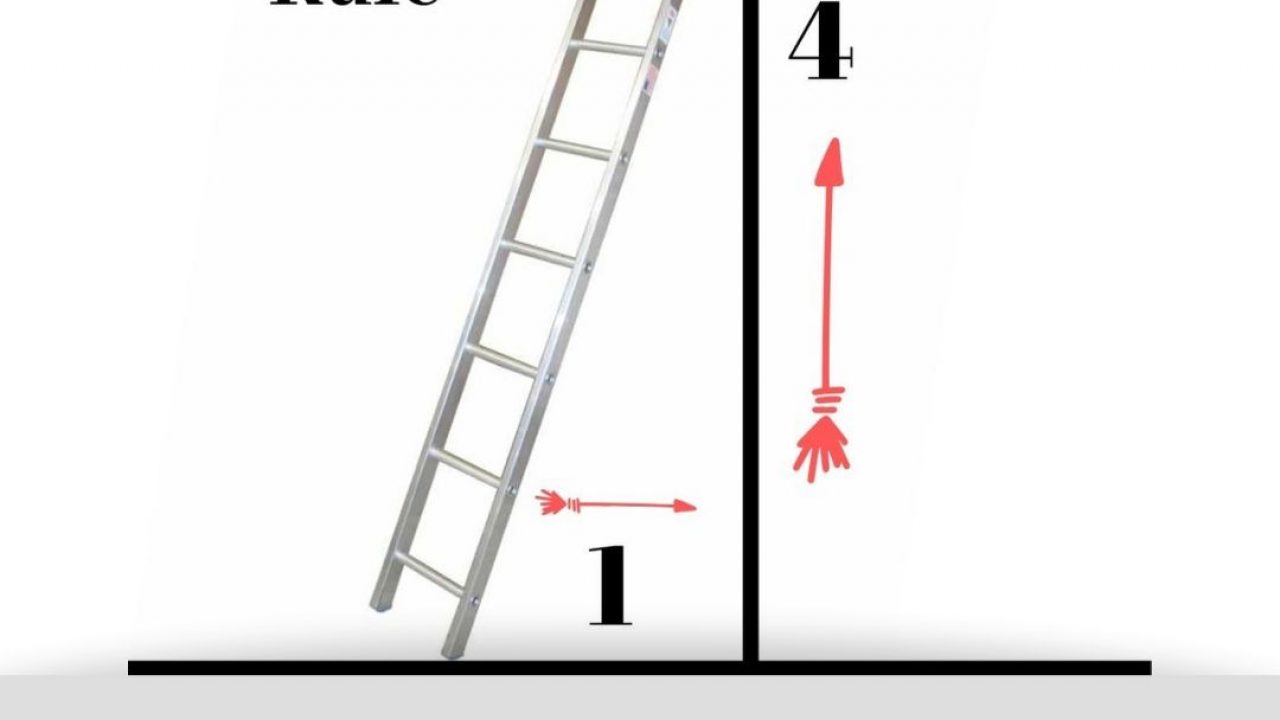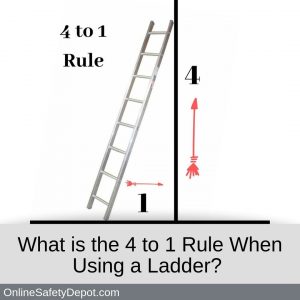The 1 in 4 Rule for ladders is crucial for safety. It ensures stability during use.
Accidents can happen when using ladders incorrectly. One key safety tip is the 1 in 4 Rule. This rule helps prevent falls and injuries. When setting up a ladder, for every four feet of height, the base should be one foot away from the wall.
This simple guideline can save lives. Understanding and applying this rule is vital for anyone using a ladder. Whether you’re a professional or a DIY enthusiast, knowing this rule ensures a safer working environment. Let’s explore the importance of the 1 in 4 Rule and how to use it correctly.

Credit: www.parkingsign.com
Introduction To The 1 In 4 Rule
Understanding ladder safety is crucial for preventing accidents. The 1 in 4 Rule is a simple yet effective guideline. It helps ensure ladders are positioned safely.
Origins Of The Rule
The 1 in 4 Rule has a long history. It was developed by safety experts. They aimed to reduce ladder-related accidents. This rule is easy to remember. It works for various ladder types.
Importance In Ladder Safety
Following the 1 in 4 Rule is vital. It helps prevent ladders from slipping. This rule states the ladder base should be 1 foot away from the wall for every 4 feet of ladder height. For example:
| Ladder Height | Base Distance from Wall |
|---|---|
| 4 feet | 1 foot |
| 8 feet | 2 feet |
| 12 feet | 3 feet |
Proper ladder placement reduces the risk of falls. It also ensures stability. Always check the ladder angle. Use the 1 in 4 Rule to position it correctly.

Credit: onlinesafetydepot.com
How The 1 In 4 Rule Works
Understanding ladder safety can prevent many accidents. The 1 in 4 Rule is a simple guideline to ensure safe ladder placement. Let’s dive into how this rule works and why it is essential for your safety.
Calculating The Ratio
The 1 in 4 Rule states that for every 4 feet of ladder height, the base should be 1 foot away from the wall. This creates a stable angle, reducing the risk of the ladder slipping or tipping over.
To calculate this, measure the distance from the ground to the top support point of the ladder. Divide this height by 4. The result is how far the base of the ladder should be from the wall.
| Ladder Height (feet) | Distance from Wall (feet) |
|---|---|
| 8 | 2 |
| 12 | 3 |
| 16 | 4 |
Practical Examples
Let’s look at some practical examples to understand this better.
- Example 1: If you are using a 12-foot ladder, the base should be 3 feet from the wall.
- Example 2: For an 8-foot ladder, place the base 2 feet away from the wall.
- Example 3: A 16-foot ladder should have its base 4 feet from the wall.
These examples show how easy it is to apply the 1 in 4 Rule. It ensures your ladder is at the right angle, making it safer to use.
Common Mistakes To Avoid
Understanding the 1 in 4 Rule for Ladders is essential for safety. Yet, many people make common mistakes that can lead to accidents. In this section, we will highlight these mistakes and provide tips to avoid them.
Incorrect Measurements
One of the most common mistakes is taking incorrect measurements. The 1 in 4 rule means for every 4 feet of ladder height, the base should be 1 foot away from the wall. Incorrect measurements can lead to a steep or shallow angle, making the ladder unstable.
- Measure the height of the ladder correctly.
- Ensure the base is at the right distance from the wall.
- Use a measuring tape for accuracy.
Ignoring Ground Conditions
Ignoring ground conditions is another common mistake. The ladder’s base must be on a level, non-slip surface. Uneven or slippery surfaces can cause the ladder to shift or fall.
- Check the ground for stability.
- Avoid placing the ladder on wet or loose surfaces.
- Use ladder stabilizers if needed.

Credit: onlinesafetydepot.com
Additional Ladder Safety Tips
Understanding the 1 in 4 Rule for ladders is crucial for safety. But ladder safety does not end there. There are additional tips to ensure your safety while using ladders. Below are some important tips to keep in mind.
Inspection Before Use
Always inspect your ladder before using it. Look for any damages or defects. Check for loose steps or rungs. Ensure there are no cracks or bends in the ladder.
Examine the ladder’s feet. Make sure they are intact and non-slip. If any part of the ladder is damaged, do not use it. Safety first.
Proper Ladder Placement
Place the ladder on a stable and level surface. Avoid placing the ladder on slippery or uneven ground. Stability is key.
Ensure the ladder is not placed near doorways or high-traffic areas. If unavoidable, make sure the door is locked or blocked. Warn others about the ladder’s presence.
The top of the ladder should extend at least three feet above the landing point. This ensures you have something to hold onto when getting off the ladder.
| Tip | Details |
|---|---|
| Inspect Ladder | Check for damages and defects |
| Stable Surface | Place ladder on a stable, level surface |
| Secure Area | Avoid high-traffic areas |
| Extend Ladder | Top should extend three feet above landing point |
Following these tips will help you use your ladder safely. Always prioritize your safety by taking the necessary precautions.
Types Of Ladders And Their Uses
Ladders come in many types. Each type serves a specific purpose. Knowing the right ladder for the job is important. It ensures safety and efficiency. Below are some common types of ladders and their uses.
Step Ladders
Step ladders are self-supporting. They have a fixed height. Step ladders are ideal for indoor tasks. These include painting walls or changing light bulbs.
Step ladders have two sides. One side is for climbing. The other side provides support. Some step ladders are double-sided. This means both sides can be used for climbing.
Here are some uses for step ladders:
- Reaching high shelves
- Changing light fixtures
- Painting walls
- Cleaning gutters
Extension Ladders
Extension ladders are not self-supporting. They need to lean against a stable surface. Extension ladders can reach greater heights. They are perfect for outdoor use.
Extension ladders have two or more sections. These sections slide apart to extend the ladder. This makes them useful for reaching roofs or tall trees.
Some common uses for extension ladders include:
- Roof repairs
- Cleaning high windows
- Trimming tall trees
- Painting the exterior of a house
| Ladder Type | Key Features | Common Uses |
|---|---|---|
| Step Ladder | Self-supporting, fixed height | Indoor tasks, painting, changing bulbs |
| Extension Ladder | Leans against surfaces, extendable | Roof repairs, trimming trees, outdoor tasks |
Emergency Procedures
The 1 in 4 Rule for Ladders is essential for safe usage. But accidents can still occur. Understanding emergency procedures ensures safety during unexpected incidents. This section will guide you through the necessary steps in case of a ladder fall.
What To Do In Case Of A Fall
If someone falls from a ladder, immediate action is crucial. Stay calm and assess the situation:
- Check for responsiveness.
- Do not move the person unless there is immediate danger.
- Call emergency services right away.
Moving a person can cause more harm. Only trained personnel should handle such situations. Wait for professional help to arrive.
First Aid Basics
While waiting for emergency services, basic first aid can make a difference:
- Bleeding: Apply pressure to the wound with a clean cloth.
- Breathing: Ensure the airway is clear. Perform CPR if needed.
- Broken Bones: Avoid moving the affected area. Use a splint if trained.
Having a first aid kit nearby is vital. Keep it stocked with essentials like bandages, antiseptic wipes, and gloves.
Remember, your immediate response can prevent further injury. Stay prepared and informed to handle emergencies effectively.
Frequently Asked Questions
What Is The 1 In 4 Rule For Ladders?
The 1 in 4 rule means placing the ladder 1 foot away from the wall for every 4 feet of ladder height.
Why Is The 1 In 4 Rule Important For Ladder Safety?
It ensures the ladder is stable and reduces the risk of falling. Proper placement is key for safety.
How Do I Apply The 1 In 4 Rule?
Measure the ladder’s height. For every 4 feet, place the base 1 foot from the wall. Simple and safe.
Does The 1 In 4 Rule Apply To All Ladders?
Yes, it applies to all straight and extension ladders. Always follow this rule for stability.
What Happens If I Ignore The 1 In 4 Rule?
Ignoring the rule can make the ladder unstable and increase the risk of accidents. Always follow safety guidelines.
Conclusion
Understanding the 1 in 4 rule for ladders is crucial for safety. This simple rule helps prevent falls and injuries. Place the ladder one foot away for every four feet of height. This ensures stability and balance. Always check the ground for stability.
Ensure the ladder is secure before climbing. Following this rule can save lives. Safety should always come first. So, remember the 1 in 4 rule next time. Stay safe and climb confidently!
Recent Posts
Maintaining clean gutters is essential for preventing water damage to your home, and choosing the best ladder for cleaning gutters can make the job much easier and safer. With so many options on the...
Best Ladder for Cleaning Caravan Roof: Top Picks for You Every Adventure!
Today we will discuss the best ladder for cleaning caravan roof. Cleaning caravan roofs is one of the crucial tasks.After many days, a caravan roof can get dirty by debris, dirt, and grime. These can...
